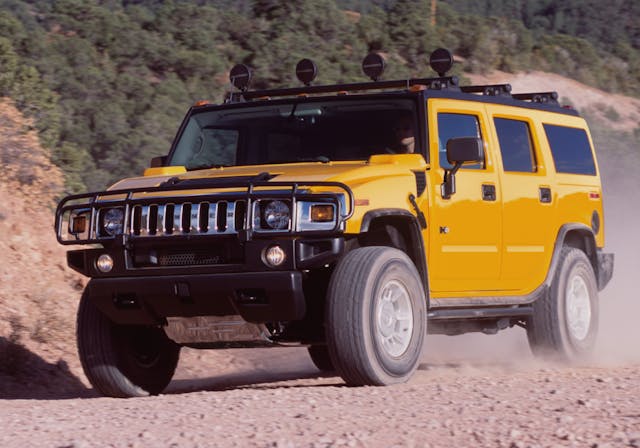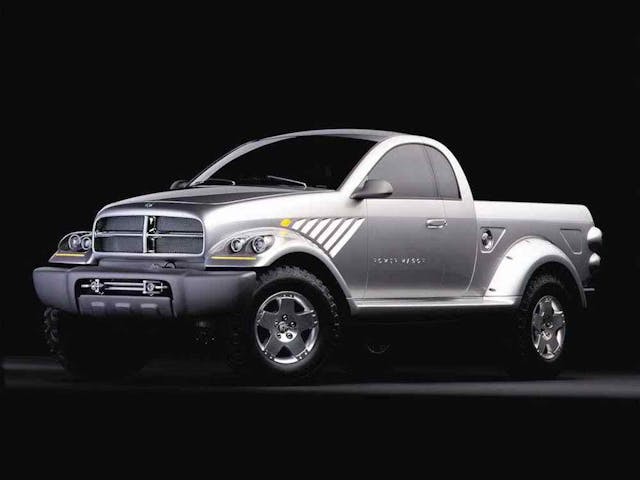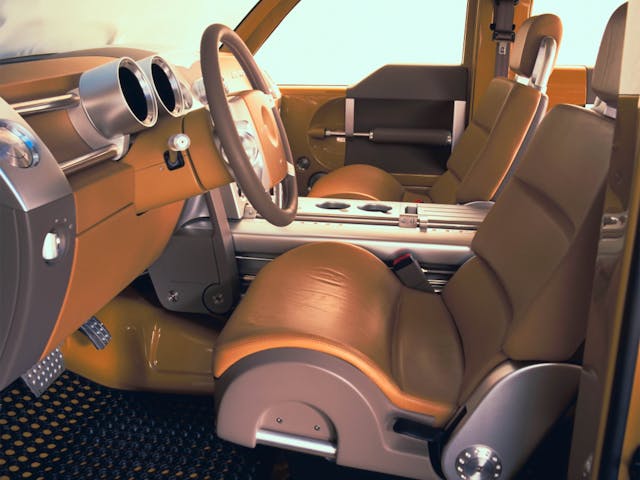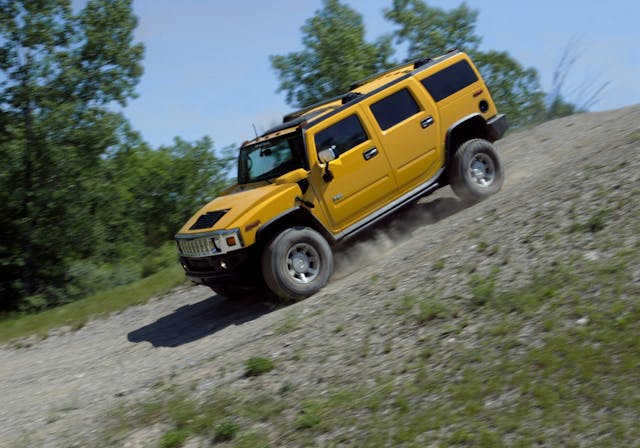Media | Articles
Could these ill-fated 2000s concepts have ensured Hummer’s survival?
As the 1990s drew to a close, conditions were perfect for kicking off the SUV onslaught that changed the automotive industry forever. While we usually identify this era with more modestly proportioned models like the Ford Explorer and the Jeep Grand Cherokee, the late ’90s also witnessed the birth of a more outrageous breed—the relatively short-lived monster sport-utility segment that produced some of the largest rigs ever to tread an American highway.
Fuel prices hovered near all-time lows, which meant that vehicle sizes began to swell. Enter models like the Ford Excursion, which in 1999 repurposed the Blue Oval’s heavy-duty pickup platform to create a three-row behemoth that towered above its also-enormous Expedition sibling. You even got a choice between V-10 and turbodiesel power.
The best example of the late-’90s rush towards plus-size proportions is the Hummer H2. Debuting for the 2003 model year, the H2 was a little late to the party but had several advantages over its big-boned rivals. Despite borrowing its mechanicals from the General Motors full-size truck bin, it co-opted its exterior styling from the iconic (yet not nearly as roadworthy) Hummer H1 built by GM subsidiary A.M. General. Marketed as a rugged off-road rig, the H2 double-dipped into the H1’s go-anywhere heritage and sold at a premium price.

All three of these elements—style, perceived capability, and prestige—gave the Hummer H2 a brief moment in the sun, scoring several solid years of sales before skyrocketing energy costs and an impending global recession took the wind out of the brand’s sales. By 2009 Hummer was history, a victim of GM’s bankruptcy reorganization as the company struggled to put together a lineup of affordable and efficient cars that appeared far more likely to survive the rough economic seas.
It’s tempting to see the Hummer brand as a blip, but the industry’s pivot towards efficient cars was equally short-lived. Today, the General and nearly every other automaker have remade their lineups almost entirely in the SUV’s image.
Marketplace
Buy and sell classics with confidence
With big back in style, we started to wonder: How might Hummer have survived the market collapse? The nameplate has now been dusted off for a glamorous electric reboot in the form of the Hummer EV—but what might have happened, back in the 2000s, to ensure that the Hummer brand never needed a revival in the first place?
In a word: Competition.
Big boosted wagon
GM wasn’t the first to recognize that it could mine its glorious off-road past to cash in on its SUV future. Fresh off its merger the year before, in 1999 DaimlerChrysler presented the Dodge Power Wagon concept, a vehicle that proudly co-opted the heavy-duty reputation of its predecessor.

At the time, the industry was obsessed with old-school shapes. Volkswagen’s New Beetle and Plymouth’s Prowler were already setting precedent for nostalgic designs like the final-generation Ford Thunderbird and the Chrysler PT Cruiser. Penned by Dodge Truck senior designer Mark Allen, the Power Wagon was the first true example of retro writ large. Allen’s oversize concept managed to remain remarkably faithful to the original, flat-fendered version of the Dodge truck that had proven itself such a hardcore workhorse following World War II.

Despite the resemblance, the Power Wagon-redux towered over its postwar predecessor, and its interior traded utility for upscale luxury. These decisions indicated that Dodge intended the model to compete for the same high-end audience that Hummer would eventually command with the H2. Its two-passenger cabin was complemented by a storage area that could be accessed via a set of rear half-doors, and it’s likely that any production version would have substituted an additional set of seats, making it more of a match for the H2 SUT (sport-utility truck) body style.

Even wilder than the Power Wagon’s extroverted appearance was the powerplant under its hood. The concept featured a six-cylinder turbodiesel engine sourced not from long-time Dodge partner Cummins but rather from heavy equipment builder Caterpillar. Rated at 300 horsepower and 780 lb-ft of twist, it shamed the comparable Cummins by nearly doubling the diesel’s torque output, but it did so by way of a strange, natural gas–derived synthetic fuel from a company called Syntroleum. The exotic fuel that did away with the sulfur in standard diesel, with the end result being big power with very low emissions.
Equator equation
Ford was also hulking up behind the scenes. In 2000, at the North American International Auto Show in Detroit, the Blue Oval debuted the Equator concept, its own interpretation of the full-size, go-anywhere sport-utility-truck theme.

It’s hard to look at the Equator from a modern perspective and not see more than a little Hummer H2 in its ultra-chunky lines. Sitting on a heavy-duty pickup chassis, the vehicle bore almost no resemblance to Ford’s existing full-size offerings, charting a bold new look that signaled the automaker was taking the all-terrain segment seriously.
The Equator incorporated a number of advanced features that most likely would have been dialed down once production began. These included fenders made from Kevlar rather than from steel, a central tire-inflation system similar to that of the Hummer H1, and a fully-independent suspension system that would, no doubt, have yielded to a cheaper stick-axle setup. As with the Hummer H3 SUT, Ford extended the open pickup bed into the passenger compartment by way of a folding bulkhead.

Trail-worthy ground clearance, adjustable coil-over suspension, and a turbodiesel engine (one that burned dino juice rather than lab-grown fare) were also in the cards for the Ford Equator, which arrived on the scene at a time when Ford had nearly turned its back on off-road rigs. The Bronco had recently been retired, the Raptor had yet to be conceived, and the only special-edition F-Series truck out there was the street-focused Lightning. This unusual outlier pointed in an entirely fresh direction for the Blue Oval.
Weathering the storm?
Why did the H2 make it to production, and not the Power Wagon or Equator? General Motors had one distinct advantage over both DaimlerChrysler and Ford when it came to the construction of a plus-size boulder-bounder: Its wholly-owned A.M. General subsidiary, which was able to devote an assembly line to the Hummer H2 at its Mishawaka, Indiana, plant.

The unique combination of ready-made H2 components sourced from pickup lines, plus available production capacity that took nothing away from its profitable stream of trucks, allowed GM to go all-in on Hummer without having to build out a back-end to steer the end product to dealerships. Its Detroit-based competitors faced a different, tougher choice: Divert resources away from their cash-cow pickups to gamble on the full-size off-road segment, which had traditionally been low-volume. Their foresight proved to be correct, as sales would peak at just under 35,000 units a year for the Hummer.
That’s high-enough volume to generate at least a little profit, but still too low to represent anything other than a rounding error on a year-end spreadsheet compared to the full-size truck juggernauts dominating both Ford and Dodge factories. It was certainly not enough to justify giving up precious line space. The Equator and the Power Wagon served as styling exercises that influenced upcoming pickup designs for each brand, with their unusual drivetrains and off-road chops essentially ignored.

In retrospect, Ford and DaimlerChrysler’s decision to stay on the sidelines looks like the right call. In the lead-up to the 2008 financial crisis customers began to turn away from the worst excesses of the SUV segment as fuel prices climbed to levels not seen for decades. H2 sales fell accordingly, and not even the presence of the smaller and marginally more thrifty H3 could turn things around for the moribund brand. The factory off-road market shrunk to a two-horse race between the right-sized Jeep Wrangler and the Toyota 4Runner, with more niche models like the Nissan Xterra and Toyota FJ Cruiser bringing up the rear.

If the Power Wagon and the Equator had stayed the course, however, there’s a slim chance that Hummer might have survived its 2009 execution. In 2010, Ford introduced the F-150 Raptor, a vehicle that weaponized the H2’s bulk while enhancing its rugged capability. Gas prices normalized, and to this day, brands can’t seem to build and stock SUVs fast enough. In 2018, Ford even went so far as to excise all but the Mustang from its passenger-car lineup.
Had DaimlerChrysler and Ford put the Power Wagon and Equator into production, perhaps they and GM could have bridged the 24 months of chaos that enveloped the industry at the end of the 2000s, thus helping Hummer survive into the current SUV golden age. Instead, one of the most recognizable names in sport-utility history was relegated to the dust heap just a few years too early.









